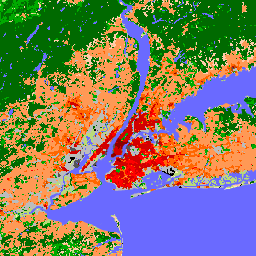
- Доступность набора данных
- 2018-01-01T00:00:00Z–2019-01-01T00:00:00Z
- Поставщик наборов данных
- Лаборатория городского климата Бохума
- Теги
Описание
С момента своего введения в 2012 году локальные климатические зоны (LCZ) стали новым стандартом для характеристики городских ландшафтов, обеспечивая комплексный подход к классификации, учитывающий микромасштабный земельный покров и связанные с ним физические свойства.
Эта глобальная карта локальных климатических зон с разрешением 100 м, репрезентативная для номинального 2018 года, составлена на основе нескольких наборов данных наблюдений за Землей и экспертных меток классов LCZ. Для большинства пользователей рекомендуется диапазон LCZ_Filter. Другой классификационный диапазон, LCZ, предоставляется только для расчета диапазона LCZ_Probability.
Схема LCZ дополняет другие схемы землепользования/земельного покрова, фокусируясь на типах городских и сельских ландшафтов, которые могут быть описаны любым из 17 классов схемы LCZ. Из 17 классов LCZ 10 отражают «застроенную» среду, и каждый тип LCZ связан с общими числовыми описаниями ключевых параметров городского полога, критически важных для моделирования реакции атмосферы на урбанизацию. Кроме того, поскольку LCZ изначально разрабатывались как новая структура для исследований городских островов тепла, они также содержат ограниченный набор (7) «естественных» классов земельного покрова, которые могут использоваться в качестве «контрольных» или «естественных эталонных» территорий.
Поскольку эти семь природных классов в схеме LCZ не могут охватить всю неоднородность существующих природных экосистем мира, мы советуем пользователям — при необходимости — объединять построенные классы LCZ с любым другим продуктом земельного покрова, который обеспечивает более широкий диапазон естественных классов земельного покрова.
Смотрите также:
Группы
Размер пикселя
100 метров
Группы
| Имя | Единицы | Размер пикселя | Описание |
|---|---|---|---|
LCZ | метров | Необработанная пиксельная глобальная карта LCZ с классами LCZ | |
LCZ_Filter | метров | Рекомендуемая глобальная карта LCZ с классами LCZ. Метки LCZ получены после применения морфологического гауссовского фильтра, описанного в работе Демузере и др. (2020). | |
LCZ_Probability | % | метров | Вероятностный слой, который определяет частоту выбора модальной LCZ для каждого пикселя (например, вероятность 60% означает, что класс модальной LCZ был выбран 30 раз из 50 моделей LCZ). Это вероятность, основанная на пикселях, полученная из LCZ-слоя. |
Таблица классов LCZ
| Ценить | Цвет | Описание |
|---|---|---|
| 1 | #8c0000 | Компактное высотное здание |
| 2 | #d10000 | Компактный среднеэтажный |
| 3 | #ff0000 | Компактный малоэтажный |
| 4 | #bf4d00 | Открытое высотное здание |
| 5 | #ff6600 | Открытая средняя высота |
| 6 | #ff9955 | Открытая малоэтажная застройка |
| 7 | #faee05 | Легкий малоэтажный |
| 8 | #bcbcbc | Большой малоэтажный |
| 9 | #ffccaa | Редко застроенный |
| 10 | #555555 | Тяжелая промышленность |
| 11 | #006a00 | Густые деревья (LCZ A) |
| 12 | #00aa00 | Разрозненные деревья (LCZ B) |
| 13 | #648525 | Кустарник, кустарник (LCZ C) |
| 14 | #b9db79 | Низкие растения (LCZ D) |
| 15 | #000000 | Голый камень или мощеный (LCZ E) |
| 16 | #fbf7ae | Голая почва или песок (LCZ F) |
| 17 | #6a6aff | Вода (LCZ G) |
Таблица классов LCZ_Filter
| Ценить | Цвет | Описание |
|---|---|---|
| 1 | #8c0000 | Компактное высотное здание |
| 2 | #d10000 | Компактный среднеэтажный |
| 3 | #ff0000 | Компактный малоэтажный |
| 4 | #bf4d00 | Открытое высотное здание |
| 5 | #ff6600 | Открытая средняя высота |
| 6 | #ff9955 | Открытая малоэтажная застройка |
| 7 | #faee05 | Легкий малоэтажный |
| 8 | #bcbcbc | Большой малоэтажный |
| 9 | #ffccaa | Редко застроенный |
| 10 | #555555 | Тяжелая промышленность |
| 11 | #006a00 | Густые деревья (LCZ A) |
| 12 | #00aa00 | Разрозненные деревья (LCZ B) |
| 13 | #648525 | Кустарник, кустарник (LCZ C) |
| 14 | #b9db79 | Низкие растения (LCZ D) |
| 15 | #000000 | Голый камень или мощеный (LCZ E) |
| 16 | #fbf7ae | Голая почва или песок (LCZ F) |
| 17 | #6a6aff | Вода (LCZ G) |
Условия эксплуатации
Условия эксплуатации
Цитаты
Демузере М.; Киттнер Дж.; Мартилли А.; Миллс Г.; Мёде К.; Стюарт И.Д.; ван Влит Дж.; Бехтель Б. Глобальная карта локальных климатических зон для моделирования экосистемы Земли и изучения окружающей среды в масштабах городов. Earth System Science Data 2022, 14, том 8: 3835–3873. doi:10.5194/essd-14-3835-2022
DOI
Исследуйте с Earth Engine
Редактор кода (JavaScript)
var dataset = ee.ImageCollection('RUB/RUBCLIM/LCZ/global_lcz_map/latest') .mosaic(); var visualization = { bands: ['LCZ_Filter'], min: 1, max: 17, palette: [ '8c0000','d10000','ff0000','bf4d00','ff6600', 'ff9955','faee05','bcbcbc','ffccaa','555555', '006a00','00aa00','648525','b9db79','000000', 'fbf7ae','6a6aff' ] }; Map.setCenter(7.26, 51.44, 6); Map.addLayer(dataset, visualization, 'LCZ_Filter');
